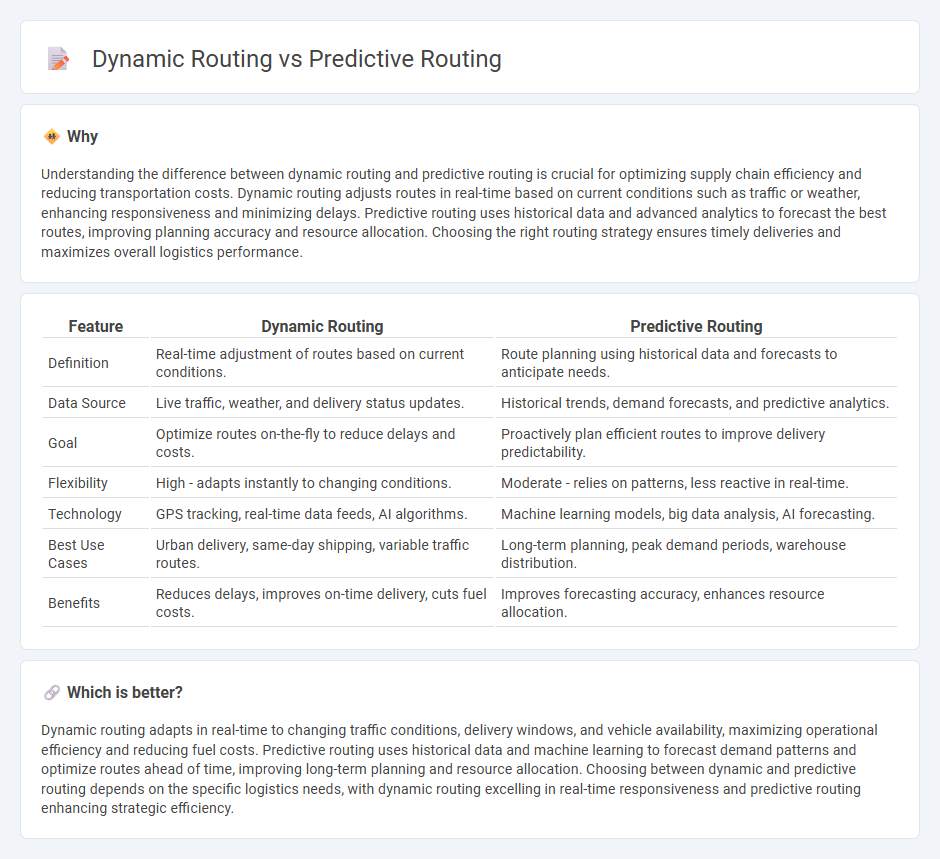
Dynamic routing adapts delivery paths in real time based on current traffic conditions, weather, and last-minute changes to optimize efficiency and reduce fuel consumption. Predictive routing leverages historical data and machine learning algorithms to anticipate future conditions and plan optimal routes in advance, enhancing reliability and service levels. Discover how integrating these routing strategies can revolutionize your logistics operations.
Why it is important
Understanding the difference between dynamic routing and predictive routing is crucial for optimizing supply chain efficiency and reducing transportation costs. Dynamic routing adjusts routes in real-time based on current conditions such as traffic or weather, enhancing responsiveness and minimizing delays. Predictive routing uses historical data and advanced analytics to forecast the best routes, improving planning accuracy and resource allocation. Choosing the right routing strategy ensures timely deliveries and maximizes overall logistics performance.
Comparison Table
| Feature | Dynamic Routing | Predictive Routing |
|---|---|---|
| Definition | Real-time adjustment of routes based on current conditions. | Route planning using historical data and forecasts to anticipate needs. |
| Data Source | Live traffic, weather, and delivery status updates. | Historical trends, demand forecasts, and predictive analytics. |
| Goal | Optimize routes on-the-fly to reduce delays and costs. | Proactively plan efficient routes to improve delivery predictability. |
| Flexibility | High - adapts instantly to changing conditions. | Moderate - relies on patterns, less reactive in real-time. |
| Technology | GPS tracking, real-time data feeds, AI algorithms. | Machine learning models, big data analysis, AI forecasting. |
| Best Use Cases | Urban delivery, same-day shipping, variable traffic routes. | Long-term planning, peak demand periods, warehouse distribution. |
| Benefits | Reduces delays, improves on-time delivery, cuts fuel costs. | Improves forecasting accuracy, enhances resource allocation. |
Which is better?
Dynamic routing adapts in real-time to changing traffic conditions, delivery windows, and vehicle availability, maximizing operational efficiency and reducing fuel costs. Predictive routing uses historical data and machine learning to forecast demand patterns and optimize routes ahead of time, improving long-term planning and resource allocation. Choosing between dynamic and predictive routing depends on the specific logistics needs, with dynamic routing excelling in real-time responsiveness and predictive routing enhancing strategic efficiency.
Connection
Dynamic routing and predictive routing are interconnected logistics strategies that optimize delivery efficiency by leveraging real-time data and forecasting algorithms. Dynamic routing continuously adjusts routes based on current traffic, weather, and delivery conditions, while predictive routing anticipates future disruptions and demand patterns using historical data and machine learning models. Combining both approaches enables logistics providers to reduce transit times, lower fuel consumption, and enhance customer satisfaction through proactive route planning.
Key Terms
Predictive Routing:
Predictive routing leverages historical data and machine learning algorithms to anticipate traffic patterns and optimize network paths proactively, enhancing efficiency and reducing latency. Unlike dynamic routing, which responds reactively to network changes, predictive routing forecasts potential congestion and reroutes data before issues arise, ensuring smoother data flow. Discover how predictive routing can transform your network performance with cutting-edge predictive analytics.
Historical Data Analysis
Predictive routing leverages historical data analysis to forecast traffic patterns, enabling proactive network management that minimizes latency and congestion. Dynamic routing, by contrast, adjusts routes in real-time based on current network conditions without relying heavily on past data trends. Explore our in-depth comparison to understand the impact of historical data on routing efficiency.
Forecasting Algorithms
Predictive routing leverages forecasting algorithms such as time series analysis and machine learning models to anticipate network traffic patterns and optimize path selection proactively. Dynamic routing, in contrast, relies on real-time network state information and reactive protocols like OSPF or EIGRP for route adjustments without predictive insights. Explore our detailed comparison to understand how forecasting algorithms enhance predictive routing efficiency.
Source and External Links
About predictive routing - Genesys Cloud Resource Center - Predictive routing uses machine learning to optimize KPIs by matching interactions with the best available agent, supporting voice, email, and various messaging platforms, while emphasizing transparency and avoiding bias in agent selection.
Predictive and Automated Routing Capabilities - Genesys's predictive routing employs AI to analyze and match customers to agents more effectively, improving key metrics like handle time and first-contact resolution by continuously learning and adapting to real-time data without manual model building.
Layer and rhythm specificity for predictive routing - Predictive routing in neuroscience refers to a rhythmic, layer-specific brain mechanism predicting and modulating sensory processing to optimize handling of expected stimuli, highlighting deep layer feedback inhibiting processing of predicted inputs.
 dowidth.com
dowidth.com